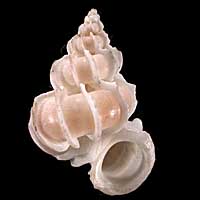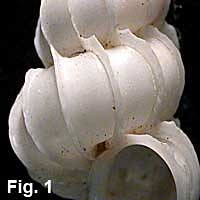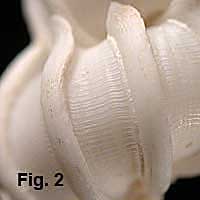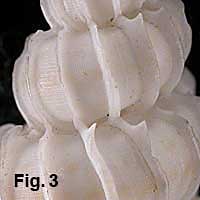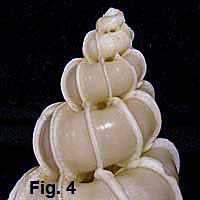|
< Previous family introduction |
|
|||||||||||||||||||||||||||||||||||||||||||||||||||||||||||||||||||||||||||||||||||||||||||||||||||||||||
|
|
Family Epitoniidae Wentletraps The shells of the family Epitoniidae are commonly known as wentletraps, derived from the German 'wendeltreppe', meaning spiral staircase. Wentletraps are best known for the elegant shells with delicate, blade-like axial ribs on partly separated helical whorls, typified by Epitonium scalare. But the family is quite diverse, with many hundreds of species spread over 30-40 genera. In the genus Epitonium there are axial ribs, often tall and blade like, but insignificant in some species. In Opalia the ribs are low, wide and strong, and in genera such as Cirsotrema there may be strong spiral cords as well as axial ribs. Epitoniids are carnivorous animals, feeding on sea anemones and corals. Some are specific to a particular species of host, while others feed across a range of hosts. They are equipped with the normal molluscan radula for rasping, but also have jaws for cutting or biting. They bite pieces off larger prey, and swallow smaller prey whole. They live attached to their prey species, or in the sand or rubble nearby. Epitoniids are protandric hermaphrodites; male first, changing to female. After internal fertilisation, eggs are laid by the female in capsules coated with sand grains. The capsules are attached along an elastic thread that is secreted by a gland on the foot of the animal. Free-swimming larvae emerge from the capsules into the sea and become widely dispersed, spending perhaps a month in the plankton. The taxonomy of the family has been unsatisfactory for at least two hundred years, and it is only since studies of the animals and their hosts were commenced in the last decade that real progress has been made. Up to then, the classification was based on shell characters, utilising the overall shell shape supplemented by the number, size and shape of the axial ribs, and the whorl sculpture between ribs. This provided an artificial classification, which did not reflect evolutionary relationships. The understanding of the family has been advanced substantially with the work of Adriaan Gittenberger, who investigating anatomy and host relationships of many species and published a phylogenetic classification of the family (Gittenberger, 2006). In NSW, 30 species of Epitoniidae are recognised, but none are common, and only two, Epitonium jukesianum and Opalia australis, are regularly encountered. The NSW species fall into the distributional groups common to other molluscs. A few species found in the tropical Indo-West Pacific faunal region are found in the north of the state, rarely reaching as far south as Sydney. Other species are restricted to the southern Australian temperate zone, which extends roughly from Sydney around southern Australia to Fremantle. Other species are known from deep water, down to 1463 metres. These rarely collected species were known only from NSW until 2003, when Nakayama (2003) recognised five of them from the Pacific coast of Japan. There are additional undescribed species, mainly from deep water, in the Australian Museum collection, usually represented by only a few specimens each. These undescribed species are not dealt with here. The NSW epitoniids were catalogued by Iredale (1936), who included 19 new species in his list. Some of his new species were based on one or a few specimens dredged from Sydney Harbour; it is unclear if these are modern or fossil shells. Some of his species are still rare, with a few only known from the holotype. Some are now recognised as being specimens of widespread tropical species. Family References Only the main references useful for identification are given here. All references mentioned in the text are listed in "References", accessible from the "Table of Contents" page.
Coverage All described species of the family known from NSW are catalogued here, with the exception the following three species. There is also a dozen or so undescribed species, mainly from deep water, not included here.
Identification Notes Ribs: The prominent axial sculptural elements on epitoniid shells are referred to as ribs. Other publications use the term costae. Shells sometimes show a varix or several varices as well as ribs. A varix is larger and stronger than a rib, being a thickening of the outer lip formed during a resting period between growth phases. A few species, such as Plastiscala moerchi, show axial ribs as well as varices. In the Epitoniidae, the number of ribs per whorl is fairly constant in some species and variable in others. In most NSW species the number of ribs is fairly constant (varying by up to 20%) and useful in identifying species, but in the most common NSW species, Epitonium jukesianum, the rib count is very variable, from 9-28 per whorl. Rib alignment: Ribs may be aligned from whorl to whorl (Fig. 3), or not aligned When aligned, there is the same number of ribs on all whorls, and the ribs join up down the spire. When not aligned, there is a different number of ribs on each whorl, usually more on latter whorls. Often, ribs are aligned on early whorls, with extra ribs being introduced only on the last one or two whorls. Rib Shape: Ribs vary widely in form; thick or thin, low or high, smooth-topped or ragged. They may be erect (Fig. 1) or rolled backwards (Fig. 2). In some species they are peaked near the top of the whorl (Fig. 3). Whorls: The whorls of the shell may be connected, or partially or completely disconnected. When connected, which is the situation in most other families of molluscs, there is no gap between whorls. When whorls are partially disconnected there is a gap between whorls, with the whorls joined only by the axial ribs (Fig. 4). This gap between whorls may be easily seen by eye, or it may be narrow and only visible with magnification. When the whorls are completely disconnected, there is no contact between successive whorls; this only occurs in one species in NSW, Cycloscala hyalina. Whorl Sculpture: The shell's surface between the axial ribs (the interspaces) may be smooth, spirally sculptured (as in E. barissum) or cancellate (as in E. tacitum). Only in a few cases is this sculpture visible by eye, but it is readily seen with 10x magnification. Intritacalx: The intritacalx is a soft, chalky layer on the shell surface of some epitoniid genera, particularly noticeable in the genus Opalia (See O. apotolorum). The intritacalx may be easily worn away, resulting in the appearance of fresh shells being quite different to that of old specimens. It is sculptured differently to the underlying shell, often with lines of microscopic pits. Identification of the NSW species of Epitonium The following table provides some distinguishing features to assist with identification of the species of the largest genus Epitonium (excluding other genera of the family) in NSW. The seven species marked with an asterisk (*) are known, in NSW, mainly from specimens dredged from Sydney Harbour by the dredge Triton in the 1930s. Many of the species obtained from Triton dredgings are fossil shells of tropical species not commonly found in NSW.
|
|||||||||||||||||||||||||||||||||||||||||||||||||||||||||||||||||||||||||||||||||||||||||||||||||||||||||
